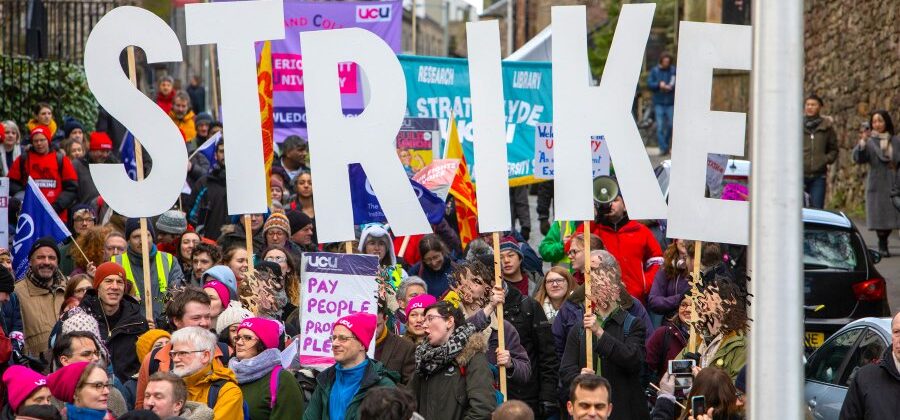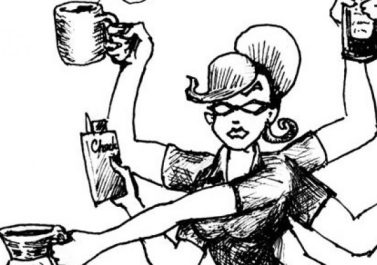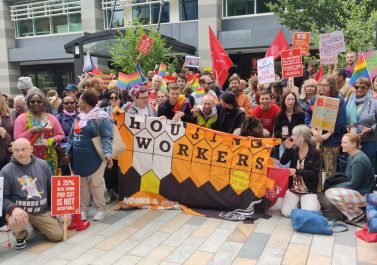Let’s Get Rooted (LGR) have been chatting about this strike for a while now. We became aware of it before the corona crisis, just after workers had been balloted. We weren’t too surprised to hear that the union had agreed to postpone the strike with the onset of the lockdown, keen as unions usually are to prove themselves as ‘reliable co-managers’ of the workforce in a time of ‘national crisis’ for a seat around the negotiating table. Then we learned that the strike was going ahead, despite many workers still working from home. We think it’s important to try and be in contact with workers on the ground in order to get a better feel of how things were playing out on the ground, especially as it’s usually difficult analyse what’s really happening from a workers’ perspective, aside from union press releases.
We consider this strike to be particularly important due to the majority of the workers involved being what are commonly now known as “key Workers”. Whilst some workers from different sectors such as the food industry have organised some unofficial actions against the lack of safety measures by employers, this strike represents the first of the formal and legal cases of a larger, collective, public sector fightback after the confusion in the capitalist work regime that came with the pandemic. We have therefore made it a priority to be in touch with workers on the ground and attend the pickets ourselves to get some first-hand impressions and insights. We do this in order to build a clearer picture of the state of the class and balance of forces in this pivotal moment, also because it may become a key reference point to other public sector workers in the UK.
Brief reportback:
We are interested in how our fellow workers have responded to the crisis. We want to know the extent to which these workers are conscious of their important role in the continuation of capitalist normalcy. We want to understand the tactics of both the union and the bosses in this dispute, as well as the sentiment of the class more broadly in the area.
With that in mind, comrades who were in the area committed to making it to the pickets in the early morning of the first day of the strike. LGR comrades were aware of the possibility of outsourced refuse workers refusing to cross a picket line if the strikers decided to form one outside their depot. Knowing this, (and that UNISON would not be organising a picket there because of the legal implications), we headed to the refuse centre for 5am on Friday. We ran into workers at the rear entrance to the depot and started having a few conversations with pickets and passers-by.
The most striking chat we had was with someone who’d just dropped by to show her support. A teacher and member of the National Education Union (NEU) was there standing with around ten striking workers. We asked her how she felt about the strikes, to which she responded, “I’m massively in support of the strikes. To be honest, everyone everywhere should be on strike!”
In the meantime, workers were piling up in the refuse centre looking to start their day. One LGR comrade noticed, “Nothing was moving in or out, the refuse trucks and school buses were penned in by cars.” By the time the depot manager arrived at 8am (2 hours later than the majority of the workers) it was clear that there was a happy standstill at the depot. Refuse workers, although many of them live quite a distance away, were more than happy to stand in solidarity with strikers. The thing that pissed them off most was that their shift officially started at 7am, but it was common knowledge that if you were to have any chance of getting a parking spot you had to turn up two hours early, so after some brief conversations it was pretty clear whose side they were on! The comrades holding a picket at the rear of the refuse centre were called over to the front side when the depot manager decided to make a 999 call to try and disperse the picket rather than, you know, talking to people and understanding the situation. Two cops arrived on the scene within 15 minutes, at around half 8. There was a pretty heated verbal exchange and the picket held its own. The two coppers, feeling a bit outnumbered, retreated to their car and presumably called for backup because 20 minutes later another 4 cops appeared. The picket at this point was a bit less animated and workers clearly felt threatened by the cops’ provocations that anyone who refused to move off the picket was liable to arrest. (Solidarity pickets are still illegal). The picket was broken, and the refuse workers slowly started to leave the depot, shouting apologies to striking workers as they left. One threw an amusing shout to the depot manager, claiming that they couldn’t leave because they were “waiting for their driver!”
It’s clear that there is real solidarity among workers here. Some of the workers did try to throw up objections to staying behind the picket to be met with firm assertations by their co-workers that, “We never cross picket lines!” The Unite shop steward said that he had come in that morning and seen that “they cut trucks over the weekend, i.e. cutting overtime”. He said he was going to call a meeting later about this. There is also a recent history of struggle amongst the Unite workers, as one comrade told us that, “the drivers went on strike several months ago over holiday pay. Sounded quite militant, police showed up. Electricity was cut off by someone. A director tried to drive one of the trucks but hit a tree.” This shows that there is a material basis for solidarity amongst workers in the area, who face similar grievances. Comrades on the picket line were talking to the refuse workers and it was pretty plain to see that they understood the need for class solidarity, regardless of the personal gains presented. These ideas are not abstract, elitist, or exclusionary. There is militancy in the working class, and it continues to be the task of revolutionaries to seek it out and support it, practically and analytically. One striking worker made it clear that, “If we had the numbers, we could have held it the refuse picket all day.”
It is clear that there is some need for strategic work amongst the workers, as some of them remarked in conversation on how the Town Hall picket was well attended, but ultimately symbolic, as there were no scabs attempting to enter through the picket. One worker said: “There was around 20-30 people outside. I had a chat with one of the Children Looked After social workers about rumours I’d heard regarding scabs in his service. He seemed confused by this, and we agreed we would look into it together.” From there, LGR comrades moved to the Housing Building, which was also well attended with around 20-30 people on the picket. Around 7 social workers had also staffed a picket down at a Pupil Referral Unit. They said, “We had heard cleaners who are in UNISON were going in to do the weekly deep clean.” Apparently no cleaners showed in the end, but this was a picket independently organised outside of the union and there was rumours, “that they Unison were reluctant to picket here due to something or other with the NEU.”
In the run-up to the strike, the union has made a lot of noise about its majority non-white workforce. One worker said “Tower Hamlets has a very black/brown female workforce, with loads of white blokes at the top.” This is worth mentioning, because as the same worker explains. “I’m not sure if I have the stats right but about 30-40% of tower hamlets workers are agency and many lost their jobs because of lockdown. Like most of the major unions Unison doesn’t have much to say about/to them… In general though imho Unison are really banging on about the BME female workforce, but notably silent on casualised staff who are also likely to be nonwhite women.” It’s important to recognise here the sinister nature and limits of union politics, where workers most requiring solidarity and support are marginalised, whilst other workers are used in a PR bid to bring support to the union, not necessarily the class itself. Going forwards workers need to be able to discuss these inequalities if they are at all able to challenge both, scabs in this dispute and broader disciplining tactics of the division of labour in their workplace.
The main strike actions were rounded off by a Zoom rally at 11:30am, attended by around 400 people.
There was also a fair presence of leftists on the pickets, from London Renters Union to Green Anti-Capitalist Front and IWW, making it clear that revolutionaries recognise the importance of this strike and what it represents. We hope to see those comrades again on Monday 8th and hopefully many more.
Thoughts and observations:
There is a buzz about this strike. Whether it is the scale of it and the variety of workers involved, or because it is the first high-profile dispute following lockdown or any other reason, we can’t be sure. It was an impressive display of workers from different branches of public sector work. The task now is to create stronger communication and solidarity between the workers – something that is usually lacking in bigger strikes like this, and which was noticeable from our walk-arounds. The organisers within Unison have done a good job in mobilising so far, but that can’t be the stopping point. Now is the time to encourage and allow the self-direction of workers through open discussion of tactics and convictions.
One of the reasons we say this is that otherwise, we will see the usual thing of ‘decisions being made behind closed doors.’ Many workers are only too aware of this tendency. One striking worker said that she thought that, “the new contracts would eventually get imposed after a bit of to-and-fro between Unison and the Council.” This lack of faith in unions to ultimately represent workers’ interests clearly demonstrates the need for more worker autonomy, particularly in moments of intensified struggle. We have said this before: whilst we don’t reject the unions wholesale in the UK, we question their place in a class strategy and believe that without the self-actualisation of workers’ collective power, the struggle inevitably stagnates or leads to a ‘sell out’.
This dispute is important beyond those who are directly involved, which is clear from the recent announcement that Croydon Council are axing 500 workers and many more (we can imagine) will soon follow suit. In the aftermath of the corona crisis, which has only exacerbated, rather than caused the problems in the economy, we are undoubtedly facing a period of reordering of the forces of production. We can expect similar cases of assaults on workers from capital in the form of redundancies, sack-and-rehire and cuts. A strong victory in this dispute will stand as an important lesson and example for the working class going forwards.
One final observation is that the union have opted for the 1-day strike structure of industrial action. Usually this is a tactic employed to minimise disruption, so it would be good for workers to discuss this strategy in more detail, as well as possible alternatives to ramp things up. Perhaps we can’t expect miracles, and we certainly can’t expect a revolutionary consciousness from any individual dispute, but we can start to ask questions around how we move towards it. It is clear that for this dispute to be successful it will need wider engagement of the working class to withstand the onslaught of the hegemonic reality that calls for cuts in the face of an intense economic downturn and 40 years of intense attack from (neoliberal) capitalism.
Of course, this was only the first day of the strike, and there is talk of more strike days being added to the current plan of three 1-day strikes. What we want to do is encourage the workers to build their own network of communication between different sites, pickets and classifications of worker. We would like to see discussions and debates between the workers around the tactics of the union. Should they focus on the Town Hall and other low impact pickets, or where “essential” work is still being carried out? Density of certain pickets vs. a more tactical distribution of workers? How does the union try to address working class residents of Tower Hamlets? Would there be an opportunity to call for joint assemblies of strikers and local residents? Through such discussion and debate, the workers would have the means to recognise the limits of certain tactics and recognise their own collective autonomy through the possibilities of others.



